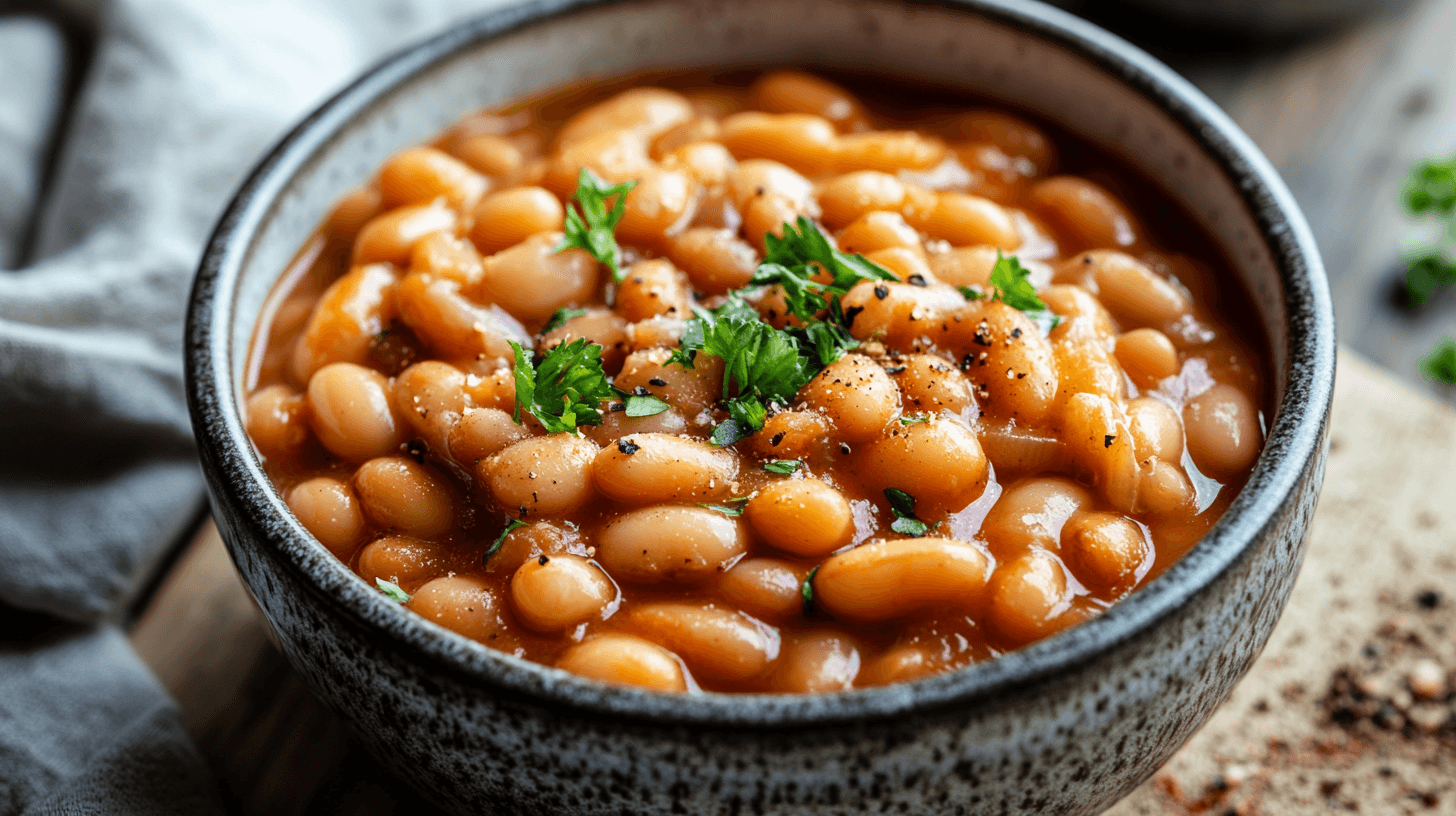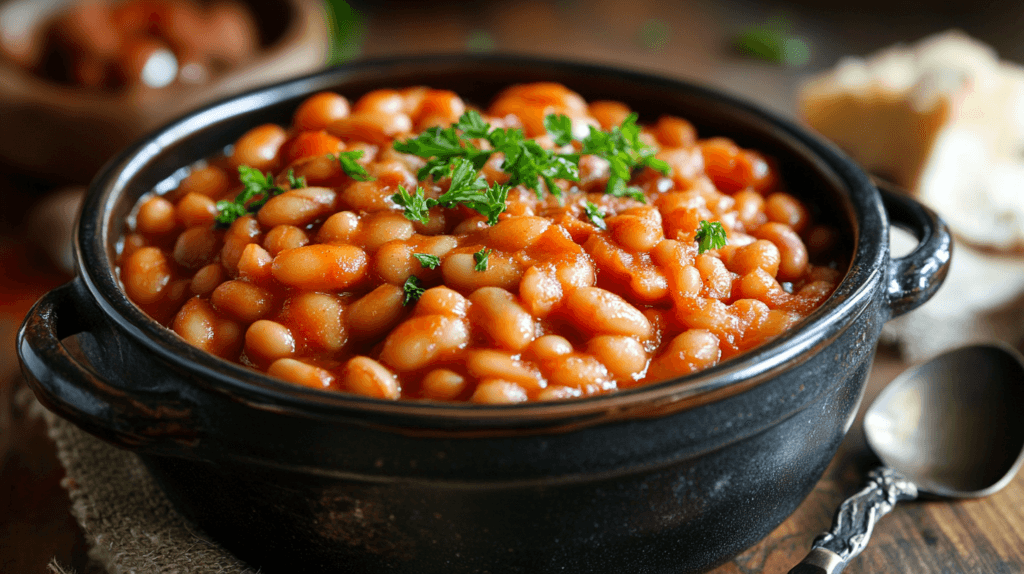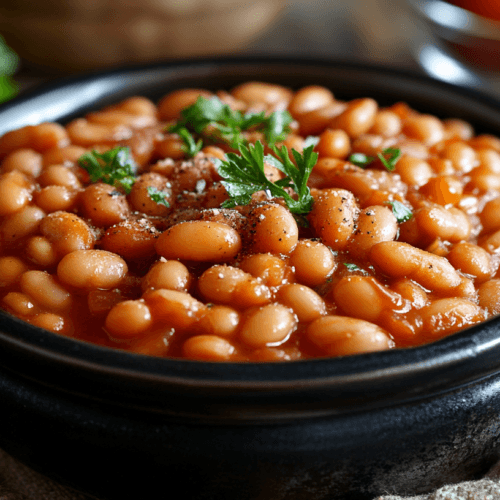Last updated on April 26th, 2025
Baked Beans Recipe are a beloved dish that has earned a spot at countless barbecues, potlucks, and family dinners. Known for their rich, smoky, and sweet flavors, baked beans are versatile, hearty, and easy to make. While canned baked beans are convenient, nothing compares to the depth of flavor in a homemade version. This comprehensive guide will walk you through a journey of mastering baked beans, complete with variations, tips, and serving suggestions.
Table of Contents
Why Make Baked Beans Recipe From Scratch?
Homemade baked beans are far superior to their canned counterparts in every way, offering a richer, deeper flavor and the opportunity to personalize every aspect of the dish. When you prepare the best baked bean recipes from scratch, you unlock a world of possibilities that canned beans simply cannot provide. Here’s why making the best baked bean dishes at home is worth your time and effort:
Customizable Flavors
Making baked beans from scratch gives you complete control over the flavors. You can tweak the sweetness, adjust the level of smokiness, or add as much spice as you desire. Whether you prefer your beans slightly tangy, extra sweet, or loaded with smoky flavor, homemade baked beans let you craft the perfect dish to suit your preferences. The easy way to make baked bean recipes is to experiment with different ingredients like barbecue sauce, smoked paprika, or chili powder to create a flavor profile that’s uniquely yours.
Healthier Ingredients
One of the greatest benefits of making the best baked bean dishes at home is the ability to use fresh, wholesome ingredients. Unlike store bought options, which often contain preservatives, high fructose corn syrup, and artificial flavorings, homemade baked beans can be made with natural, nutrient rich components. You can opt for organic beans, reduce the sugar content, and use healthy fats like olive oil, ensuring that the easy way to make baked bean dishes aligns with your health goals.
Adaptability
Another reason to make the best baked bean recipes at home is their adaptability. Homemade baked beans can be tailored to suit various dietary needs or flavor preferences. For instance, you can easily create vegetarian baked beans by omitting bacon and adding smoked paprika for a plant based smoky flavor. If you’re in the mood for something bold, you can whip up spicy baked beans by adding hot sauce or jalapeños. The easy way to make baked bean variations is to experiment with different ingredients and cooking methods, ensuring you never get bored of this classic dish.
By choosing to make the best baked bean recipes from scratch, you gain full control over the quality, flavor, and versatility of the dish. Plus, the easy way to make baked bean recipes ensures that this process is simple, rewarding, and far tastier than relying on canned alternatives. Enjoy the satisfaction of creating a baked bean dish that is both delicious and uniquely tailored to your taste.
For more ways to explore comforting dishes, discover versatile recipes for your kitchen. If you’re health conscious, learn how to adapt traditional recipes, like baked beans, to a low carb diet.

Essential Ingredients for Perfect Baked Beans Recipe
Core Ingredients:
- Navy Beans: Creamy and tender, navy beans are the classic choice.
- Bacon or Ham Hock: Adds a smoky depth (vegetarian substitutions are covered below).
- Onions and Garlic: The aromatic foundation for building flavor.
- Molasses and Brown Sugar: Provide the signature sweetness and caramelization.
- Tomato Paste: Balances sweetness with tanginess.
- Mustard and Apple Cider Vinegar: Enhance the sauce with tangy notes.
- Spices: Smoked paprika, chili powder, and black pepper elevate the flavor.
Optional Add Ins:
- Maple Syrup: For a lighter, sweet flavor.
- Barbecue Sauce: Adds depth and complexity.
- Hot Sauce or Jalapeños: Ideal for spicy baked beans.
Tools You’ll Need
- Dutch Oven or Baking Dish: Essential for slow cooking and even heat distribution.
- Mixing Bowls: For preparing the sauce and combining ingredients.
- Skillet: To sauté bacon, onions, and garlic.
- Spatula and Whisk: For stirring and combining ingredients.
Step by Step: Classic Baked Beans
1. Prepare the Beans
Soak 2 cups of navy beans in water overnight. This reduces cooking time and ensures a tender texture. Drain and rinse the beans, then boil them in fresh water for 1-1.5 hours until tender. If you’re short on time, canned beans can be a substitute, but the flavor won’t be as robust.
2. Create the Sauce
In a skillet, cook:
- Bacon or Ham Hock: Dice and sauté until crispy. Remove and set aside.
- Onions and Garlic: Sauté in the rendered fat until softened and aromatic.
Add the following to the skillet:
- ¾ cup of molasses
- ½ cup of brown sugar
- 2 tablespoons of tomato paste
- 1 tablespoon of mustard
Simmer the mixture for 5 minutes, allowing the flavors to meld and the sauce to thicken slightly.
3. Combine and Layer
Preheat your oven to 325°F (160°C). In a Dutch oven or baking dish:
- Combine the cooked beans, prepared sauce, and crispy bacon or ham hock.
- Stir in 1 cup of water or broth to maintain moisture during cooking.
4. Bake to Perfection
Cover the dish with a lid or foil and bake for 2-3 hours. Stir occasionally, and remove the cover for the last 30 minutes to allow the top layer to caramelize.
Tips for Perfect Baked Bean Recipe
- Use Fresh Beans: Opt for dried navy beans for a richer flavor and better texture.
- Balance the Sweetness: Adjust the molasses and sugar to avoid overpowering the dish.
- Keep Moisture Levels Right: Add water or broth during baking to prevent drying out.
- Stir Occasionally: Ensures even cooking and prevents sticking.
Popular Variations of Baked Beans
1. Vegetarian Baked Beans
- Replace bacon with olive oil for sautéing onions and garlic.
- Add smoked paprika or liquid smoke for that signature smoky flavor.
2. Spicy Baked Beans
- Increase chili powder and add hot sauce or diced jalapeños for heat.
- Garnish with fresh cilantro for a zesty kick.
3. Sweet Maple Baked Beans
- Substitute molasses with maple syrup for a lighter sweetness.
- Add pecans for an unexpected nutty crunch.
Common Mistakes to Avoid
- Overcooking Beans: This can turn them mushy; keep an eye on cooking times.
- Neglecting to Stir: Leads to uneven cooking and dry patches.
- Using Too Much Sweetener: Can overpower other flavors. Balance is key.
Serving Suggestions
Baked beans are versatile and pair beautifully with various dishes. Here are some serving ideas:
- Barbecue Favorites: Serve alongside ribs, pulled pork, or grilled chicken.
- Breakfast Spread: Pair with eggs, sausages, and toast for a hearty meal.
- Complementary Sides: Match with banana bread muffins for a satisfying mix of savory and sweet.
Storing and Reheating Baked Beans
Baked beans are perfect for meal prep and reheating:
Storing:
- Refrigerate in an airtight container for up to 5 days.
- Freeze in a freezer safe container for up to 3 months.
Reheating:
- Warm gently in a saucepan over medium heat, adding a splash of water or broth to loosen the sauce.
- Alternatively, reheat in a microwave safe dish.

FAQ’s About Baked Beans
Q: What are the ingredients of baked beans?
The core ingredients of baked beans include navy beans, molasses, brown sugar, tomato paste, mustard, and spices like smoked paprika and black pepper. Many recipes also include bacon or ham hock for a smoky flavor, but vegetarian versions replace this with olive oil or smoked paprika. These ingredients combine to create the rich, sweet, and tangy sauce that baked beans are known for.
Q: What can I add to baked beans to make them taste better?
To elevate the flavor of baked beans, consider adding:
- Barbecue Sauce: Adds a smoky depth and tanginess.
- Chopped Onions and Garlic: Sautéed onions and garlic enhance the aromatic base.
- Spices: Chili powder or cayenne for heat, or cinnamon for a subtle warmth.
- Sweeteners: Maple syrup or honey for a natural sweetness.
- Vegetables: Bell peppers or diced tomatoes for added texture and flavor.
Experimenting with these additions can transform a basic baked bean dish into something truly unique and tailored to your taste.
Q: What’s the difference between Boston baked beans and regular baked beans?
Boston baked beans are a specific variety of baked beans, distinguished by their heavy use of molasses and salt pork. This gives them a richer, darker, and sweeter flavor compared to regular baked beans, which often use a lighter sauce with less molasses and more tomato based ingredients. Boston baked beans are traditionally slow cooked in a clay pot, emphasizing their deep, caramelized flavor.
Q: Is it better to steam or bake green beans?
The choice between steaming and baking green beans depends on your desired texture and flavor. Steaming green beans retains their bright color, nutrients, and crisp tender texture, making it ideal for simple side dishes. On the other hand, baking green beans (especially when roasted with olive oil, garlic, and spices) results in a caramelized, flavorful dish with a softer texture. Both methods are excellent, depending on the context of your meal.
Q: Can I make baked beans in a slow cooker?
Yes! Combine all the ingredients in a slow cooker and cook on low for 6-8 hours. This method enhances the flavors while requiring minimal effort. Slow cooking allows the beans to absorb the sauce deeply, resulting in a rich and hearty dish.
Q: How do I make baked beans less sweet?
To balance the sweetness of baked beans, reduce the amounts of molasses and brown sugar. Instead, add more tangy ingredients like mustard, apple cider vinegar, or even a splash of lemon juice. These acidic components help cut through the sweetness and create a more balanced flavor profile.
Q: Are baked beans gluten free?
Yes, baked beans are naturally gluten free when made from scratch using whole ingredients. However, it’s essential to check pre made items like mustard, barbecue sauce, or tomato paste, as they may contain hidden gluten. Always read labels carefully if gluten free compliance is necessary.
Q: Can I skip soaking the beans?
Soaking beans is recommended for even cooking and to reduce cooking time, but you can skip this step if needed. Use the quick soak method by boiling the beans for 1 minute and letting them sit for an hour before cooking. Alternatively, you can use canned beans for convenience, though they may not absorb the sauce as effectively as dried beans.
Q: How do I prevent baked beans from drying out?
To keep baked beans moist, add water or broth as needed during cooking. Always cover the dish during the first part of the baking process to lock in moisture. If you notice the sauce thickening too much, stir in additional liquid and reduce the heat slightly.
By addressing these questions, you’ll have all the knowledge needed to create a perfect batch of baked beans that suits your tastes and dietary needs. Whether you’re elevating the flavor, making adjustments for texture, or exploring variations, baked beans are a dish that can be endlessly customized.
Final Thoughts
This baked bean recipe is a celebration of comfort food done right. With its perfect balance of sweetness, smokiness, and richness, it’s guaranteed to be a hit at your next gathering or family meal. Whether you stick to the classic recipe or experiment with the suggested variations, you’ll find these baked beans irresistible.
For more recipe inspiration, explore comforting and versatile dishes. If you’re ready to experiment, try pairing baked beans with a savory and sweet option like easy orange chicken or a hearty breakfast with banana bread muffins. Enjoy cooking and sharing this timeless dish!

Baked Beans
Equipment
- Large Oven-Safe Skillet or Dutch Oven
- Wooden Spoon
- Measuring Cups
- Knife
- Cutting Board
Ingredients
Main Ingredients
- 2 slices bacon diced
- 1 small sweet onion diced
- 1 bell pepper diced
- 2 cloves garlic minced
- 1 tablespoon smoked paprika
- 0.25 to 0.5 teaspoon chipotle chili powder to taste
- 1/4 teaspoon salt
- 1/4 teaspoon freshly cracked black pepper
- 2 tablespoons apple cider vinegar
- 2 tablespoons BBQ sauce
- 2 tablespoons ketchup
- 1 tablespoon Dijon mustard
- 1 tablespoon brown sugar
- 2 cans (22 ounces each) baked beans recommended: Bush’s Grillin’ Beans
Optional
- 2 slices bacon for topping
Instructions
- Preheat oven to 400°F (200°C). In a large oven-safe skillet, cook diced bacon over medium-low heat until crisp and fat is rendered.
- Stir in diced onion, bell pepper, and minced garlic. Cook, stirring often, until softened (about 5 minutes).
- Add smoked paprika, chipotle chili powder, salt, and pepper. Stir and cook for another 1–2 minutes.
- Stir in apple cider vinegar, BBQ sauce, ketchup, Dijon mustard, and brown sugar until combined.
- Add canned baked beans (do not drain). Stir well and bring mixture to a boil, then turn off heat.
- If desired, lay extra bacon slices on top. Transfer skillet to the oven and bake for 30–35 minutes until bubbly and thickened.
Notes
External Resources for Baked Bean Recipes and Nutrition
Here are some authoritative and trusted resources to deepen your understanding of baked bean recipes and their nutritional value:
- Nutritional Benefits of Beans
- Learn about the health benefits of beans, including their high protein and fiber content, from the U.S. Department of Agriculture (USDA). This resource provides comprehensive information on bean varieties and their role in a healthy diet.
- Safe Food Preparation Tips
- Ensure your baked beans are prepared safely by following the guidelines provided by the U.S. Food and Drug Administration (FDA). This site includes essential tips on handling canned goods, cooking temperatures, and food storage.

